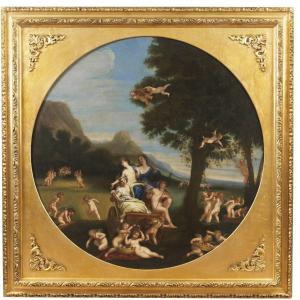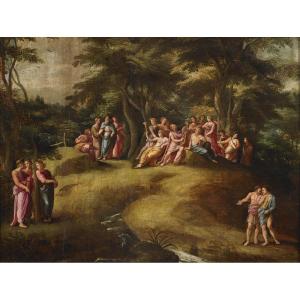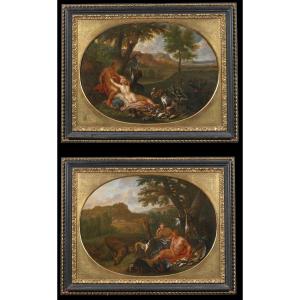An oil on canvas, Cignani, the painter who painted it around 400 years ago, did not intend to represent our planet, but rather the natural element that, together with fire, air and water, makes up the Universe, according to the idea of the world handed down by the ancients.
In the painting, the Earth takes the form of a goddess who governs the cycles of nature and generously offers her fruits to putti who take care of her, protecting her and working hard.
The chromatic impact is beautiful with these light and warm tones that blend with the peace and tranquillity of Nature.
The painting has typically Bolognese characteristics; Felice Cignani reached lofty qualitative peaks in describing the Emilian countryside with grace and sensitivity, exhibiting a clear similarity with the works of Francesco Albani and his Father Carlo; the canvas under examination is a shining example of his art with a real but idealised view of the Bolognese countryside interpreted with Arcadian sensitivity and classical concreteness
The patches of trees executed with a free and rapid brushstroke, the warm burnished colours, the atmospheric rendering of the rising clouds, the physicality of the putti, all in a well-balanced composition of his landscapes with an Arcadian pastoral flavour, constitute the most significant elements of his painting, all of which are also well represented in our canvas.
In the extraordinary pictorial staging, the skilful setting in a primordial and idyllic natural foreshortening, perfectly organised in relation to the lively and crowded parade of characters, in which an effective sense of motion and a beautiful effect of depth is imprinted, acquires great significance.
The composition under consideration draws its inspiration, albeit with variations in artistry and scale, from the Allegory of the Earth in the Galleria Sabauda in Turin, part of a cycle of four tondi inspired by the Elements and executed by Francesco Albani between 1625 and 1628 for the superb collection of Cardinal Maurizio of Savoy (brother of Duke Victor Amadeus I), who had been fascinated by the Stories of Venus and Diana painted by Albani for Scipione Borghese before 1622.
These compositions enjoyed enormous critical acclaim and were extraordinarily praised by European collectors for their aesthetic and decorative value, in which myth and nature find full landscape ideality.
The paintings and works of art published here are my exclusive property and therefore are always available to be viewed, by appointment, in my exhibition sites located in Sanremo and Brescia.
This item , like all our objects, is sold accompanied by a photographic certificate FIMA of authenticity and lawful origin; this document identifies the object by adding more value to the article.
We take care and personally organize the packaging and shipping of our items with insurance all over the world.
Mr. Riccardo Moneghini
Storico dell' Arte






































 Le Magazine de PROANTIC
Le Magazine de PROANTIC TRÉSORS Magazine
TRÉSORS Magazine Rivista Artiquariato
Rivista Artiquariato